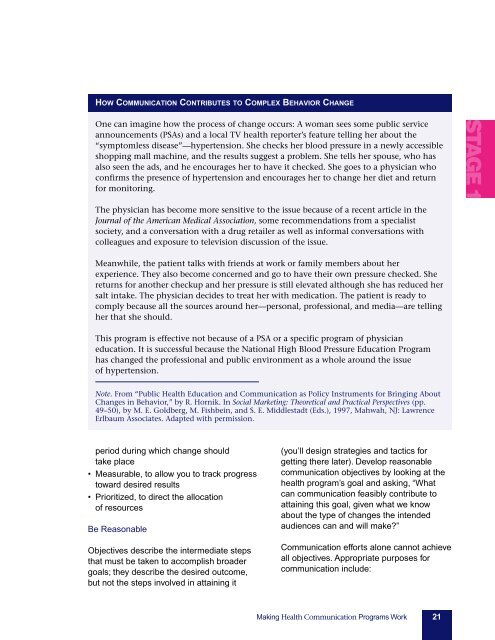pink-book
pink-book
pink-book
Create successful ePaper yourself
Turn your PDF publications into a flip-book with our unique Google optimized e-Paper software.
HOW COMMUNICATION CONTRIBUTES TO COMPLEX BEHAVIOR CHANGE<br />
One can imagine how the process of change occurs: A woman sees some public service<br />
announcements (PSAs) and a local TV health reporter’s feature telling her about the<br />
“symptomless disease”—hypertension. She checks her blood pressure in a newly accessible<br />
shopping mall machine, and the results suggest a problem. She tells her spouse, who has<br />
also seen the ads, and he encourages her to have it checked. She goes to a physician who<br />
confirms the presence of hypertension and encourages her to change her diet and return<br />
for monitoring.<br />
The physician has become more sensitive to the issue because of a recent article in the<br />
Journal of the American Medical Association, some recommendations from a specialist<br />
society, and a conversation with a drug retailer as well as informal conversations with<br />
colleagues and exposure to television discussion of the issue.<br />
STAGE 1<br />
Meanwhile, the patient talks with friends at work or family members about her<br />
experience. They also become concerned and go to have their own pressure checked. She<br />
returns for another checkup and her pressure is still elevated although she has reduced her<br />
salt intake. The physician decides to treat her with medication. The patient is ready to<br />
comply because all the sources around her—personal, professional, and media—are telling<br />
her that she should.<br />
This program is effective not because of a PSA or a specific program of physician<br />
education. It is successful because the National High Blood Pressure Education Program<br />
has changed the professional and public environment as a whole around the issue<br />
of hypertension.<br />
Note. From “Public Health Education and Communication as Policy Instruments for Bringing About<br />
Changes in Behavior,” by R. Hornik. In Social Marketing: Theoretical and Practical Perspectives (pp.<br />
49–50), by M. E. Goldberg, M. Fishbein, and S. E. Middlestadt (Eds.), 1997, Mahwah, NJ: Lawrence<br />
Erlbaum Associates. Adapted with permission.<br />
period during which change should<br />
take place<br />
• Measurable, to allow you to track progress<br />
toward desired results<br />
• Prioritized, to direct the allocation<br />
of resources<br />
Be Reasonable<br />
Objectives describe the intermediate steps<br />
that must be taken to accomplish broader<br />
goals; they describe the desired outcome,<br />
but not the steps involved in attaining it<br />
(you’ll design strategies and tactics for<br />
getting there later). Develop reasonable<br />
communication objectives by looking at the<br />
health program’s goal and asking, “What<br />
can communication feasibly contribute to<br />
attaining this goal, given what we know<br />
about the type of changes the intended<br />
audiences can and will make”<br />
Communication efforts alone cannot achieve<br />
all objectives. Appropriate purposes for<br />
communication include:<br />
Making Health Communication Programs Work 21


